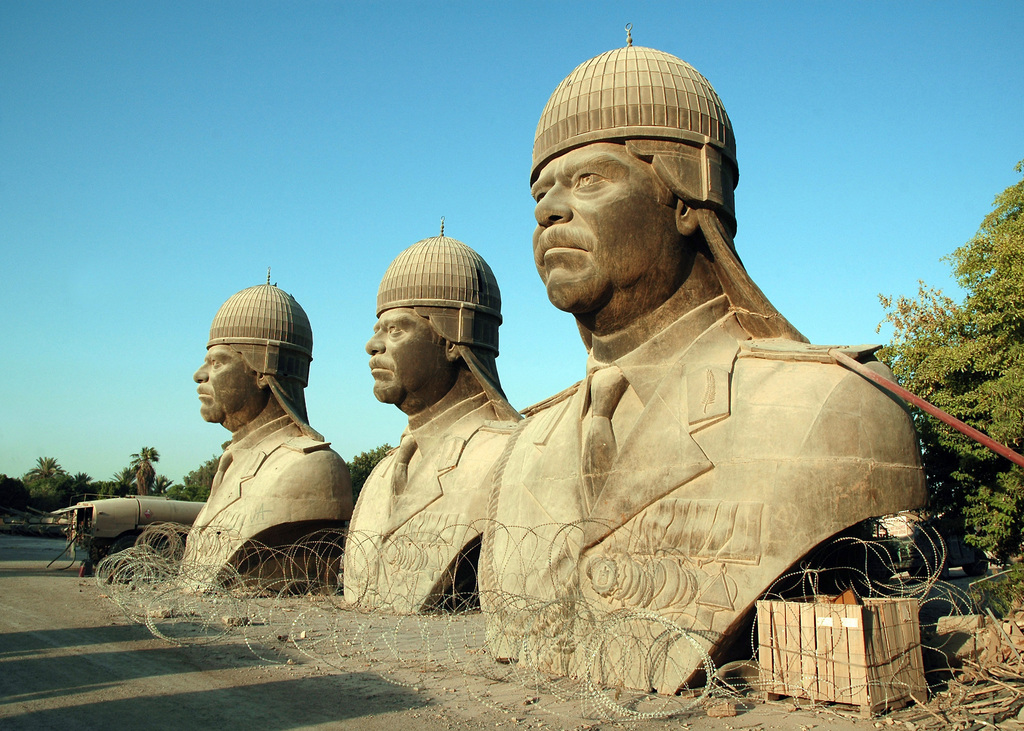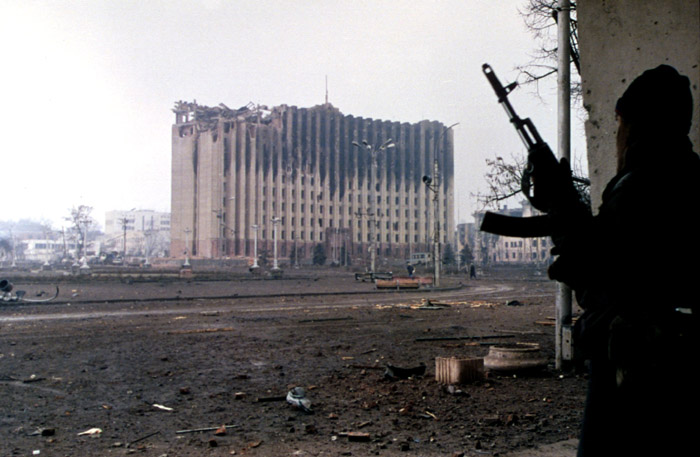When Aiming for Your Adversary’s Achilles Heel May Lead to Shooting Yourself in the Foot
A review of Steve Coll, “The Achilles Trap: Saddam Hussein, the CIA and the Origins of America’s Invasion of Iraq” (Penguin Random House, 2024)

Published by The Lawfare Institute
in Cooperation With

Steve Coll’s latest work, “The Achilles Trap: Saddam Hussein, the CIA and the Origins of America’s Invasion of Iraq,” seeks to explain why Saddam Hussein would put his regime at risk over weapons of mass destruction (WMD) that didn’t exist. As is now known, Saddam ordered his biological and chemical stockpiles destroyed in 1991 but still spent years obfuscating or disrupting international arms inspections. Coll answers the book’s central question with a metaphor: The “Achilles Trap” refers to how both sides imagined a “fatal flaw in their opponent that did not actually exist.”
Unlike a number of other studies, Coll’s account does not focus on the George W. Bush administration’s rush to war or the failings of the U.S. intelligence community during the lead-up to the conflict. Coll gives those topics their due, but “The Achilles Trap” takes a much longer view of the misunderstandings that plagued the U.S.-Iraq relationship, from the Iranian Revolution to Saddam’s downfall. Coll suggests that, throughout this relationship, the United States misread Saddam’s intransigence and deception. At the same time, Saddam assumed the CIA knew his WMD programs didn’t exist, which only reinforced his long-standing belief that the United States (likely in league with Israel) was seeking to engineer his ouster without regard to WMD.
Coll gives as much attention to the inner workings of the Iraqi regime as he does to the deliberations of successive U.S. administrations. “The Achilles Trap” benefits from Coll’s dogged pursuit of audio recordings, transcripts, and minutes of meetings that U.S. forces recovered after the U.S.-led invasion in 2003. Between 2010 and 2015, the Defense Department made these records available to the public through the Conflict Records Research Center. After the center closed for budgetary reasons, the government withdrew the records from the public domain. Coll then relied on a Freedom of Information Act lawsuit to get access. Saddam was nearly Nixonian in his tendency to self-record, and Coll’s use of those tapes and related materials pays off in the firsthand insights into Saddam’s thinking they provide. Coll balances these sources with interviews from other key figures from the Iraqi nuclear program, the U.S. government, and the United Nations. Coll’s efforts result in a highly readable and revealing account.
Saddam’s Rise
The early chapters of “The Achilles Trap” chart Saddam’s rise during the 1960s and 1970s. Through skill and serendipity, Saddam consolidated power within Iraq’s Baath Party as it steered Iraq through a period of revolutionary fervor. In 1979, Saddam was vice president when then-president (and Saddam’s cousin) Ahmed Hassan al-Bakr retired. Saddam’s tenacity and luck were rewarded, and he became president at only 42.
Coll paints the portrait of a vicious but industrious ruler, as Saddam transitioned into the strongman that defined his regime. Readers learn about the inner workings of running a pariah state. Some of these dynamics are almost comically routine. Saddam must deal with budget meetings just as any other administrator. Less routine are the internecine family squabbles—“management challenges,” as Coll writes—that required Saddam’s attention. Saddam was no virtuous mediator. Instead, Coll uses the familial anecdotes to demonstrate the chaos that may ensue when a dictator employs unstable relatives to control various parts of his government. In one particularly gripping episode, “The Achilles Trap” details how in 1988 Saddam’s eldest son, Uday, reportedly came close to killing Saddam in a fit of rage as the two quarreled over Uday’s killing of Saddam’s bodyguard, Kamel Hana Gegeo.
The Reagan Administration: My Enemies’ Enemy Is My Friend
America becomes a more persistent presence in “The Achilles Trap” as events tip into the 1980s. Coll underscores how the Reagan administration’s commitment to realpolitik ultimately set the stage for repeated attempts to engage Iraq as part of its Middle East strategy. Yes, by 2002 President George W. Bush was including Iraq in the famous “Axis of Evil.” But about 20 years prior, his father as vice president could have played a major role in deciding that Saddam was a worthy enough partner to receive American weapons and intelligence.
The Reagan administration initially saw engagement with Iraq as a pathway to getting Syrian forces out of Lebanon in 1983. Some White House advisers believed that those withdrawals would return stability to the region following the bombing of the Marine barracks in Beirut. There was no love lost between Saddam and Syrian President Hafez al-Assad, despite their shared Baathist affiliation, so this goal proved unrealistic.
Toward the middle of the decade, the administration’s interest in Iraq shifted to preventing an Iranian victory in the Iran-Iraq War. It is at this point, both historically and narratively, that the CIA became America’s pivotal bridge with Saddam. Coll approaches his examination of the CIA in “The Achilles Trap” with flair and a critical eye. The book is unsparing in describing the agency’s analytic hubris, enduring collection gaps, and fragile covert action programs toward Iraq. These characterizations emerge over time in the book. In the early 1980s, though, Coll describes a humbler agency posture as the administration sought to stand up its partnership: Baghdad station was situated in one of “America’s more decrepit outposts in the Middle East” and the senior agency interlocutor—Thomas Twetten—resembled “a bank officer with abstemious habits.”
Humble appearances did little to weaken Saddam’s expectations of a conspiracy. For the Iraqi leader, Coll notes, the early period of this partnership was a “fevered, confusing experience” of America as “an ally, enemy, and manipulative force in the Middle East.” Saddam harbored an unshakable idea that there was always some scheme guiding America’s engagement in the Middle East; that America lurked behind every tree. Contemporary observers of America’s role in the Middle East may marvel at the idea of a (viable) grand American strategy for the Middle East, but Coll offers ongoing indications throughout “The Achilles Trap” to indicate Saddam’s paranoia-cum-mystique was authentic.
The Iran-contra affair of the late 1980s confirmed Saddam’s paranoia. Coll writes that the episode reinforced for Saddam the conspiracy foretold, namely, that “Israel and Iran were in cahoots, and the [CIA] was their silent partner.” (The Israelis had a history of quietly providing arms to Iran prior to the scandal. In 1985, Israel secured the Reagan administration’s blessing to transfer U.S. anti-tank missiles to Iran. The latter transfer, designed to facilitate the return of hostages held by Iranian proxies in Lebanon, helped trigger the scandal.) As with other anecdotes in “The Achilles Trap,” the value in retelling this history comes from the added insight of reading Saddam’s firsthand reactions from direct evidence. Surprisingly, Saddam continued to work with the United States. Coll assesses the fact that Saddam had been proved correct actually made engaging Washington easier for him to stomach.
The late 1980s also gave rise to some uncomfortable truths about America’s proximity to atrocity, according to “The Achilles Trap.” Saddam’s use of chemical weapons against Iran during the Iran-Iraq war is well documented. What is less obvious—and where Coll contributes—is how some of that usage appeared to benefit from American intelligence, including information supplied by the Defense Intelligence Agency under a program known as Druid Leader, which built on the CIA’s information-sharing initiative with the Iraqis. Satellite imagery from Druid Leader helped the Iraqi Air Force target Iranian military positions starting in early 1988. Coll notes that nearly two-thirds of Iraq’s chemical weapons attacks overlapped with the Druid Leader dialogue. Coll concludes that “[t]here was no practical way to prevent the Iraqis from using Druid Leader intelligence to plan chemical attacks against Iranian forces.” Coll leaves it to the reader to read between the lines, but even the suggestion of American intelligence enabling Iraqi chemical attacks should be unsettling.
The Reagan administration also appears to have been initially uninformed about and, later, tragically indifferent to Iraqi atrocities against Kurdish civilians in 1988. While Coll is careful to note that there is no “public evidence” that American intelligence was used to support the gassing campaigns against civilian Kurdish populations, he also highlights how the administration lobbied against sanctioning Iraq once they came to light. Countering Iran remained the priority.
“The Achilles Trap” illustrates how the 1980s was a time of “furtive collaboration” between the United States and Iraq. It was not a trust-filled era, but one in which Washington and Baghdad leveraged each other’s assets to improve their individual strategic positions. If this hard-nosed approach meant occasionally overlooking the other side’s indiscretions, then so be it.
The Gulf War
The book’s tone shifts with the 1990s. The Gulf War and the United Nations WMD inspections embody Coll’s central example of miscommunications between Baghdad and Washington. It was those misunderstandings, Coll assesses, that drove the breakdown in Saddam’s relationship with the West.
This exploration starts with the Gulf War. Coll offers dutiful coverage of wartime events. But “The Achilles Trap” stands out with its thesis that stronger messaging from the United States might have deterred Saddam from invading Kuwait and, ultimately, prevented the U.S. invasion of Iraq in 2003. Coll notes that Saddam backed down on using chemical weapons against Israel or the United States when presented with clear redlines. He argues that conveying a similarly strong and unambiguous message on Kuwait could have convinced Saddam to hold back in that instance as well. Coll largely—and rightfully—absolves then-U.S. Ambassador to Iraq April Glaspie of this failure. He rests the responsibility, instead, on President George H.W. Bush, whom the book portrays as initially hesitant to take a hard line with Saddam for fear of jeopardizing deeper U.S. economic ties with Iraq.
Counterfactuals are tricky because they are generally impossible to prove. That is certainly the case with the counterfactual that Coll posits. What is evident from “The Achilles Trap” is that Saddam’s posture toward the United States changed following the fall of the Soviet Union. “[G]etting along with Washington was no longer a priority[]” for Baghdad, Coll writes, in part because Saddam believed America would use its now unchecked influence to control the flow of oil and bolster Israel even more. He was also desperate to get rid of $10 to $15 billion in debt that Iraq owed Kuwait from the Iran-Iraq War. Given these realities, it may be just as likely that no message from the United States would have been strong enough to prevent Saddam’s invasion.
Coll tees up these reflections in a professional and balanced way. But it’s not wrong to infer his belief that clearer messaging would have helped the United States avert its first—and potentially its second—war with Iraq.
Relations didn’t repair after hostilities ended in 1991. Instead, Coll discusses the implications of Saddam’s erraticism and growing U.S. disdain. The two sides became “trapped” in a cycle of misperceptions throughout the 1990s.
The Clinton Administration and the Beginnings of the U.S. Commitment to Regime Change
Following his defeat in the Gulf War, Saddam actually emerged emboldened. He lost the war, but Bush lost the election. Bush’s political defeat reinforced Saddam’s confidence in his ability to survive U.S. pressure. Saddam would continue to oscillate between a long-standing paranoia and episodic hubris toward the United States. This mindset, according to Coll, dimmed the odds of any rapprochement.
Within the United States, in the early 1990s, newly elected President Clinton ramped up covert action initiatives to foster regime change. Following the Gulf War, the United States believed Iraq’s dissatisfied population just needed a push toward revolution. The discovery of an Iraq-linked assassination plot targeting former President Bush in 1993 also stoked U.S. animus during this period—and earned Saddam the lasting enmity of the Bush family. (Coll turns out to be more than a little skeptical that the plot was traceable to Saddam. “The Achilles Trap” questions whether it might instead have been an effort by Kuwait’s security services to discredit Saddam in Washington’s eyes.)
The CIA initially deemed heavy reliance on regime change to be unwise, according to “The Achilles Trap.” But the Clinton administration nonetheless pumped money into spinning up short-lived paramilitary operations in Kurdistan and an ill-fated partnership with the ascendant Ahmad Chalabi. These ill-planned misadventures reflected the administration’s focus on the Middle East peace process. Saddam represented little more than a distraction.
In parallel, “The Achilles Trap” provides a compelling account of the inspection effort, one that reads like a spy thriller, with car chases, CIA tradecraft, and made-for-TV standoffs between Saddam’s goons and bookish scientists. Coll uses these cat-and-mouse anecdotes from the early to mid-1990s to provide a different angle on the deteriorating trust between the West and the Iraqi regime. According to Coll, Saddam had no reason to cooperate with the inspections because he calculated that doing so would only expedite his removal. Saddam assumed that the CIA already knew he had no WMD stockpiles and that American claims that he was hiding something were simply part of an elaborate campaign to secure his ouster. Saddam never seriously contemplated the simple idea that the CIA was in the dark.
During this time, Saddam’s lack of cooperation became proof for the United States that he was hiding something. UN inspectors suspected a grand denial and deception campaign. The reality, again, was more mundane. Saddam’s harsh ruling style incentivized the Iraqi bureaucracy to act suspiciously in the presence of foreign inspectors. As Coll writes, “When U.N. inspectors did find stray files touching on WMD, Baathist authorities launched investigations into how the mistake had occurred and who should pay.” Scientists confronting the prospect of execution might be counted on to go to extra lengths to ensure nothing made it into the hands of the inspection teams. Also, because of Saddam’s misdirection, many Iraqis simply weren’t sure the country didn’t have a nuclear weapons plan in the first place.
In 1998, Saddam announced the end of Iraq’s cooperation with the inspections. In response, U.S. and U.K. warplanes bombed various targets throughout the country. The dialogue between Iraq and the West had ended.
U.S. Invasion and Its Aftermath
Coll uses the final section of the book to describe the process leading to President George W. Bush’s decision to invade. Here, the last 100 pages of narrative lose some steam. It’s true that Saddam’s story cannot be told without covering his demise, which in turn requires excavating how America entered into a paradigmatic “war of choice.” Washington-centric studies focus on bureaucratic politics at the top of the Bush administration and institutional failures within the intelligence community. “The Achilles Trap,” by contrast, situates America’s war fever in a much longer history of misunderstandings between the two countries.
This journey proves more interesting than the destination. Coll is at his best when painting a portrait of Saddam and the people who sought to influence him; “The Achilles Trap” is as much a story of individuals as it is a story of history. Sympathetic Iraqi scientists, Saddam’s unhinged inner circle, earnest American spies, and derring-do UN weapons inspectors generally keep the narrative from dragging. The Vulcans, who assume center stage as “The Achilles Trap” marches toward its inevitable conclusion, are the least interesting subjects among this otherwise colorful cast.
It pays to mind the stories we tell ourselves. Saddam lost his regime, and his life, in part because he saw America as an omniscient puppeteer seeking to dominate the Middle East. The United States put thousands of troops in harm’s way in pursuit of a rogue WMD program that turned out to be a fiction. A highly compelling read, “The Achilles Trap” shows that when misperception collides with myth, tragedy often follows.





